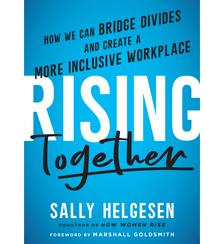Workplace inclusion: Easier said than done?
In her new book, Sally Helgesen looks at the triggers that leave us divided and defeated, and the practices that can help colleagues, teams, and organizations rise together.

Gallup’s annual State of the Global Workforce poll found that only 15% of employees reported feeling actively engaged by their work in 2019. So, it’s hardly surprising that the added pressure of the pandemic would set off the exodus of workers that’s become known as the “great resignation” or the “great attrition.”
This was a crisis waiting to happen. And it’s created a fresh imperative for organizations, and for every one of us, to get better at inclusion and belonging. This is the challenge of our historical moment.
I have spent the last 35 years working in 38 countries around the globe, always with a dual mission. I help women and other traditional outsiders to recognize, articulate, and act on their greatest strengths, and identify internal barriers that could hold them back. And I help organizations build inclusive cultures that enable the largest possible number of people to contribute their best talents.
This work has given me the opportunity to interview thousands of people in wildly varied settings. I’ve sat up into the wee hours in Tokyo sushi bars where senior executives loosened their ties, ordered another round of sake, and bemoaned the cultural constraints that keep their organizations stuck. I’ve listened to female artificial intelligence engineers in Silicon Valley and Singapore—among the most educated and skilled women on the planet—describe their fear of being perceived as “too ambitious” if they speak directly about their skills and aspirations.
These and thousands of other disparate encounters have convinced me that there’s never been a better time for us to collaborate broadly on helping one another to rise. Given the whiplash instability and economic tensions that have been a hallmark of the 2020s so far, this may strike some as wildly optimistic, especially given the very real divisions that the disruptions of the last ten years have kicked up.
Yet, organizations have grown increasingly serious about doing what it takes to engage the broadest possible range of people. Leaders no longer expect, as many did even 20 years ago, that a highly diverse workforce will simply adjust to business as usual, or that people will repress what is distinctive about themselves in an effort to fit in.
As the chief information officer of a Fortune 100 manufacturing company based in the Midwest recently confided, “We’ve finally gotten the message that we need to meet our people where they are. And that we have a lot to learn from them.”
Just as important, individuals in companies who once may have felt like outsiders, unsure of their role or their prospects, have become far more assured of the value they have to contribute and more determined to be recognized for their potential.
Growing confidence at all levels is, in fact, one of the primary reasons that people are increasingly willing to abandon jobs that may look good on paper but that they perceive as demeaning, unsatisfying, a poor fit for their talents, or a potential dead end. This strengthened confidence has also led to greater solidarity, as those who in the past were perceived as outsiders have become more eager to support one another and more skilled at doing so.
Growing confidence at all levels is, in fact, one of the primary reasons that people are increasingly willing to abandon jobs that may look good on paper.
Today, senior leaders are more likely to view supporting women at less senior levels as an opportunity to distinguish themselves, enhance their visibility, and build useful connections. In sum, a good career move. And because many senior women have by now benefited from these initiatives, they regard participation as a way to “pay it forward” by actively advocating for those who are coming up. I see a similar evolution in networks that serve people of color and sexual minorities.
History teaches that solidarity is powerful, with amplifying effects that can transform even situations that seem hopelessly entangled. Whereas mighty organizations—or nations, for that matter—can be quickly paralyzed by infighting and division, extraordinary things can happen at warp speed when people come together and focus on the we rather than the they.
Rising Together identifies both the triggers that can undermine this evolution as well as the practices that support it. I believe this practice-based approach is powerful, precisely because it’s rooted in everyday experience rather than policy or theory. It offers a bottom-up path to change that gives every one of us the opportunity to shape the cultures of which we are a part.
“It’s not fair” is a losing game
The belief that we’ve been treated unfairly can trigger us like little else, igniting resentment, anger, frustration, and disappointment. My colleague Marshall Goldsmith goes so far as to describe fairness as a “nonstop triggering machine.” The machine kicks into high gear, because, despite daily evidence that life can and often is profoundly unfair, we continue to expect that we should be treated fairly.
Letting go of our it’s-not-fair radar can be tough for many reasons. One is the strong emotional response most of us have when we perceive that we’ve been treated unfairly. Another is the social and political environment, which over the last decade has encouraged a focus on grievance and division and kept us on high alert for any potential harm. Such terms as microaggression make this clear, as do accusations of “reverse privilege.”
But we also struggle to align our expectations with reality, because we are primed to believe that our organizations operate—or should operate—as meritocracies, rigorously allocating rewards in proportion to contribution.
Extremely successful people in systems that claim to be meritocratic often justify massively outsized rewards by citing how incredibly hard they’ve worked—as if a single parent holding down two or three jobs in order to make ends meet might enjoy similar blessings if he or she would only buckle down. In this way, people tie themselves into mental knots and assume indefensible positions rather than admit one of the world’s most obvious truths: that luck, circumstances, and the conditions of birth and parentage disproportionately advantage some people and disadvantage others. And that while hard work is usually a factor in success, it is rarely on its own sufficient.
The language of sports, widely used to describe our lives at work, can also mislead our expectations in regard to fairness. Sports teach many useful lessons about persistence, grit, teamwork, and the patience required to develop complex skills. But the culture of sports offers little help in environments in which policies must constantly adjust to shifting business conditions, technological disruptions, global reverses, and evolving leadership commitments. Although we often speak of it as such, a career is not a game. The conditions that shape organizations are never static, and ground rules vary in response, so the game analogy rarely applies.
Nor does the metaphor of the “level playing field,” which is also adapted from sports, translate into how most organizations function. Sports exist in the physical world, which means that good design and the right equipment can make the actual field or surface of play sufficiently level to avoid anomalies that consistently favor one side or the other.
In organizations, by contrast, the field is metaphorical, an imagined ground on which individuals with wildly differing advantages start at different levels and encounter different hurdles. Getting the lay of the land may require inside information. A curveball means one thing on the mound, another in the performance-review process. The ground in organizations is always shifting beneath our feet.
Rules? Whose rules?
Or take the notion of rules. Here, too, sports analogies can be misleading. Sports take place in a defined space and time, and follow rules that can be listed, referred to, adjudicated, and appealed.
Even the person on the field with the most positional authority—the manager, the greatest-of-all-time superstar, the owner—can get tossed if he or she mounts a too-strenuous objection.
In sports, rules triumph over position.
Organizations, by contrast, operate according to stated but also unstated rules and reflect diffuse or opaque lines of authority. To take a flagrant example, the strategic plan for the entire company may have been devised by an outside consultant with zero investment in its execution, which means there is no appeal when things go wrong. Influence and personal relationships also play an outsized role in determining where power is vested in organizations—one reason that rules-based objections often get ignored. In organizations, power and rules dance around each other.
Questions of fairness, potentially fluid in organizations, can create an environment in which we are quick to contest one another’s beliefs about what constitutes fairness because our differing experiences shape wildly different interpretations. This keeps the culture in turmoil in a way that can have both positive and negative effects.
On the positive side, people from nondominant groups have over the last few decades been relentless in raising awareness about the role bias can play in hiring, promotion, and assessing performance. As a consequence, those in decision-making positions are now far more likely to recognize and seek to address systemic unfairness.
Why are there no women on this list of candidates for the VP spot? Could these criteria disadvantage minority candidates? Should we cast a wider net instead of always favoring graduates of elite schools?
Such observations, common today, were rarely heard in the past. As Marshall Goldsmith observes, “There has probably never been a time in history when senior leaders were less racist and sexist than they are now. But there has also never been a time when more complaints are being lodged.”
While these complaints do keep the pressure on the larger culture, adopting a negative focus as individuals can keep us stuck, setting us against one another, deepening divides, and igniting our human tendency to pass judgment.
Resentment may cause us to restrict workplace socializing to people we perceive as being like us or seek confirmation for narratives about how we never get a fair shake because… (fill in the dots). Or we may turn inward, losing heart and concluding “it’s just not worth it,” because we feel unappreciated and disregarded.
In this way, the fairness trigger can undermine our capacity to make the best of our talents, collaborate broadly, focus on the big picture, and enjoy our work. The negative energy that drives many it’s-not-fair narratives can also diminish our ability to effectively advocate for the larger changes we seek to see put in place.
From the bottom up
I was profiling the Miami Herald, which had historically been viewed by a large proportion of employees as having a divisive and deeply unfair culture. In addition to the antagonistic divide between the business and editorial sides that one typically finds at newspapers, those who worked on the English and Spanish editions rarely communicated. A physical wall had even been erected between them, because the English speakers found the Spanish-speaking employees “too loud.” The wall was routinely cited as a metaphor for the larger culture.
At the start of the 1990s, the Herald hired a new publisher, Dave Lawrence, a newspaper executive with a reputation for bringing people together and instilling an ethic of excellence. Under his leadership, the paper would win five Pulitzer Prizes.
Near the start of his tenure, Dave announced a “fairness initiative” aimed at identifying what the Herald needed to do to become a fairer place. But rather than bringing in consultants or charging human resources with devising and implementing new policies, Dave took a bottom-up approach, recruiting a team of 40 employees to form a fairness task force.
Team members were drawn from every level and division, with a fairly equal representation of senior and junior people and of men and women. The purpose of the task force was to identify where people throughout the company perceived unfairness and come up with recommendations based on that. The only ground rule was that the entire group had to reach consensus on every suggestion it endorsed.
As one participant told me, “The process ended up taking six very long months. It really tried my patience, because reaching consensus with people who have different experiences and opinions is time-consuming and painful. But what I learned was that getting on the same page with someone requires you to listen to a lot of things you may disagree with, not judging but trying to understand the other person’s point of view. Doing this over and over changed me as a human being. You can’t change an organization unless the people in the organization change.”
When at last the task force presented 26 recommendations, Dave Lawrence’s leadership team signed off on every one. Dave then asked task force members to work with HR to identify specific policies and practices that could make their suggestions a reality. Again, this was not a rapid process, because a lot of people were involved and because working groups were asked to come to consensus on what they decided.
Task force members virtually had to train HR in the collaborative process they had used; some in HR were resistant, and one senior leader left. But the relationships that developed as the group worked through volatile issues resulted in widespread trust that this was the right approach.
The long-term impact of the fairness taskforce was extraordinary, with staff members later attributing the paper’s ability to support the community and keep publishing during the catastrophe of Hurricane Andrew as a direct result of how they had learned to work together.
Decades later, I still view Dave Lawrence’s approach as the most effective route for addressing issues of fairness. Giving everyone a forum to share perceived inequities and having the process managed by employees at a range of levels who work to achieve consensus is always going to take longer and be messier than handing the task off to a team of professionals.
And focusing on fairness for all, rather than fairness for one group, regardless of how much that group has struggled with unfairness, is always going to win broader support.
Author profile:
- Sally Helgesen is the author of eight books on leadership, most recently Rising Together: How We Can Bridge Divides and Create a More Inclusive Workplace. She delivers workshops and keynote addresses around the world and has been a contributor to strategy+business since 2005.
- From the book Rising Together: How We Can Bridge Divides and Create a More Inclusive Workplace, by Sally Helgesen. Copyright © 2023 by Sally Helgesen. Reprinted by permission of Hachette Go, an imprint of Perseus Books LLC, a subsidiary of Hachette Book Group Inc., New York, NY. All rights reserved.




